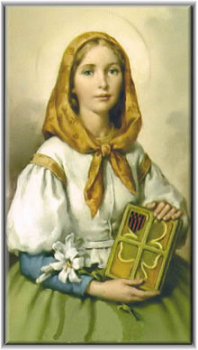St Dympna and St Isidore the Farmer

St Dympna
Martyr. Possibly seventh century. Patron of the mentally ill. Few facts are known about this ancient saint but her memory has been very influential. According to legend, she was the daughter of a British or Celtic king. When his wife died, he developed an incestuous attraction for Dympna. In an effort to escape his attentions, she fled with her confessor St Gerebernus, to Antwerp, and then to Gheel. Her father tracked them down and found them living as hermits. When they refused to return, the king killed his daughter and had his servants kill the priest.
Both bodies were buried on the spot. In the 13th century they were reburied - an occasion marked by many cures of epileptics and people suffering from insanity. From that time on, the town of Gheel has developed a wonderful record of caring for the mentally ill.
In modern times it has pioneered their treatment in the homes of farmers and other local residents.
See also: ICN 10 May 2016 Bishop Moth speaks out on mental health ahead of St Dymphna's Day www.indcatholicnews.com/news.php?viewStory=30041
and St Isidore the Farmer
Farm labourer, married man. Born in 1070, Isidore entered the service of John de Vergas, a wealthy landowner from Madrid, when he was about ten years old. He worked faithfully on his estate outside the city for the rest of his life. He married a young woman who also became a saint - Maria de la Cabeza. They had one son.
Isidore used to rise early in the morning to go to church. His fellow workers sometimes complained about him when he arrived at work late after spending too long in church.
During his holidays he used to visit the churches of Madrid and surrounding areas. He also prayed all day long, as he walked behind the plough.
Isidore was known for his generosity to the poor. There are accounts of him miraculously finding supplies of food for them. He also had a great concern for the proper treatment of animals.
He died on this day in 1130, and was declared a saint in 1622 with Ignatius of Loyola, Francis Xavier, Teresa of Avila and Philip Neri. Together, the group is known in Spain as 'The Five Saints.' He is now a patron saint of farmers and rural communities and patron of Madrid.












